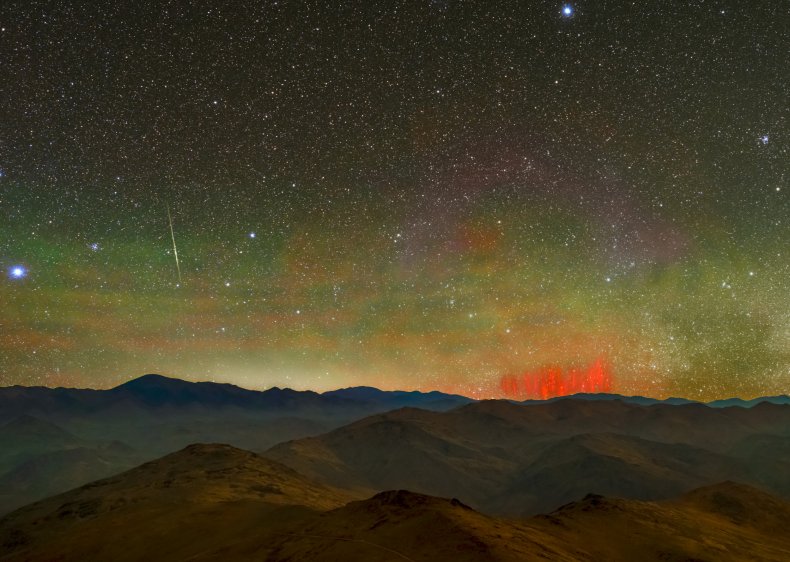BY JESS THOMSON
ON 8/25/22
A rarely seen aerial phenomenon involving bright red streaks floating in the sky was photographed above the Atacama Desert in Chile on August 22.
The mysterious lights, known as "red sprites," were snapped at the European Southern Observatory's (ESO) La Silla Observatory, in the middle of the desert around 100 miles northeast of the city of Coquimbo.
Red sprites are so rare that they were only photographed for the first time in 1989, although legends of the scarlet lights have been reported anecdotally for centuries.
According to ESO, red sprites are a rare form of lightning very high in the Earth's atmosphere. Occurring between 30 and 55 miles high, in the troposphere layer of the atmosphere, the red lights are caused by large-scale, low-temperature electrical discharges above thunderclouds.

A picture taken at La Silla shows the red sprites hovering near the horizon over the Atacama, surrounded by another, larger greenish glow. According to the ESO, this is known as airglow, which can only be seen clearly when there is no light pollution. It's caused by nitrogen and oxygen atoms in the Earth's atmosphere, that have electrons knocked away by sunlight during the daytime, slowly recombining with their electrons, a process that causes them to glow.
Red sprites have been thought to have caused the crash of a weather balloon in 1989, which fell from a height of 120,000 feet after it passed over a thundercloud, crash-landing near Graham, Texas.
What Is A Red Sprite? Rare Phenomenon Photographed In Chile Explained
A rarely seen aerial phenomenon involving bright red streaks floating in the sky was photographed above the Atacama Desert in Chile on August 22.
The mysterious lights, known as "red sprites," were snapped at the European Southern Observatory's (ESO) La Silla Observatory, in the middle of the desert around 100 miles northeast of the city of Coquimbo.
Red sprites are so rare that they were only photographed for the first time in 1989, although legends of the scarlet lights have been reported anecdotally for centuries.
According to ESO, red sprites are a rare form of lightning very high in the Earth's atmosphere. Occurring between 30 and 55 miles high, in the troposphere layer of the atmosphere, the red lights are caused by large-scale, low-temperature electrical discharges above thunderclouds.
The European Southern Observatory's picture of the red sprites over the Atacama Desert in Chile, taken from the La Silla Observatory.
ZDENEK BARDON/ESO
Red sprites can take several forms: very large Jellyfish sprites that can have areas measuring up to 30 square miles, Column sprites, and Carrot sprites, which are similar to column sprites except they also have long tendrils. These lower tendrils tend to be blue in color, while the higher parts of the sprite will appear red.
According to the University of Washington's Department of Earth and Space Sciences, the red color of the sprites comes from the excitation of molecular nitrogen in the atmosphere caused by the discharge from thunderclouds.
The reason that they are so rare is that the type of lightning discharge that causes them is also rare: sprites are directly correlated with positive cloud-to-ground lightning strikes from large thunderclouds, which comprise only 10% of all lightning. Usually, lightning strikes transfer a negative charge from the cloud to the ground.
High-speed videos taken of red sprites using a 10,000 frame-per-second camera showed that they are made of clusters of ionization balls, measuring between 33 and 328 ft across.
Red sprites can take several forms: very large Jellyfish sprites that can have areas measuring up to 30 square miles, Column sprites, and Carrot sprites, which are similar to column sprites except they also have long tendrils. These lower tendrils tend to be blue in color, while the higher parts of the sprite will appear red.
According to the University of Washington's Department of Earth and Space Sciences, the red color of the sprites comes from the excitation of molecular nitrogen in the atmosphere caused by the discharge from thunderclouds.
The reason that they are so rare is that the type of lightning discharge that causes them is also rare: sprites are directly correlated with positive cloud-to-ground lightning strikes from large thunderclouds, which comprise only 10% of all lightning. Usually, lightning strikes transfer a negative charge from the cloud to the ground.
High-speed videos taken of red sprites using a 10,000 frame-per-second camera showed that they are made of clusters of ionization balls, measuring between 33 and 328 ft across.
A picture taken at La Silla shows the red sprites hovering near the horizon over the Atacama, surrounded by another, larger greenish glow. According to the ESO, this is known as airglow, which can only be seen clearly when there is no light pollution. It's caused by nitrogen and oxygen atoms in the Earth's atmosphere, that have electrons knocked away by sunlight during the daytime, slowly recombining with their electrons, a process that causes them to glow.
Red sprites have been thought to have caused the crash of a weather balloon in 1989, which fell from a height of 120,000 feet after it passed over a thundercloud, crash-landing near Graham, Texas.
No comments:
Post a Comment